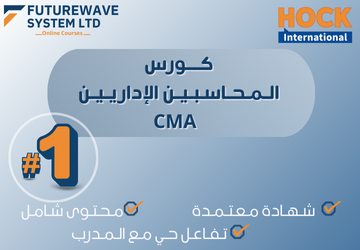What you will learn?
Section A –(1) – External Financial Reporting Decisions
About this course
Online CMA Course
Professional preparation to pass the CMA certification successfully in Saudi Arabia, the Middle East, and Sudan.
✔️ 100+ hours of video lectures
✔️ 2,200+ multiple-choice and essay questions
✔️ Accredited e-textbooks by HOCK International
✔️ Full-length mock exams
✔️ Expert CMA support tailored to the region
Course covers:
Financial Reporting (IFRS)
Planning, Budgeting & Forecasting
Performance & Cost Management
Internal Controls
Technology & Financial Analytics
Join now to enhance your financial skills and stand out in the job market across the Middle East and Sudan!
Comments (0)
The objective of financial reporting is to provide financial information about a company that is useful for making decisions about providing resources to the company.
Study Unit 1: A.1. The Financial Statements, the Balance Sheet
Study Unit 2: A.1. Comprehensive Income and the Income Statement
Study Unit 3: A.1. The Statement of Comprehensive Income
Study Unit 4: A.1. Statement of Owners’ Equity and Notes to FS
CMA part one Lecture 1
Balance sheet
Study Unit 5: A.1. Statement of Cash Flows – Introduction
Study Unit 6: A.1. Operating Activities, the Indirect Method
Study Unit 7: A.1. Investing and Financing Activities, SCF Disclosures
Study Unit 8: A.1. Integrated Reporting
Study Unit 9: A.2. Accounts Receivable
Study Unit 10: A.2. Inventory and Inventory Tracking Methods
Study Unit 11: A.2. Inventory Count, Errors, and Valuation
CMA part one Lecture 2
Balance sheet
Study Unit 12: A.2. Investments Overview, Debt Securities
Study Unit 13: A.2. Equity Investments
Study Unit 14: A.2. Business Combinations and Consolidations
Study Unit 15: A.2. Recording Fixed Assets
Study Unit 16: A.2. Depreciation of Fixed Assets and Impairment
Study Unit 17: A.2. Intangible Assets
CMA part one Lecture 3
Balance sheet
Study Unit 18: A.2. Reclassification of Short-Term Liabilities
Study Unit 19: A.2. Warranties
Study Unit 20: A.2. Accounting for Income Taxes
Study Unit 21: A.2. Leases
Study Unit 23: A.2. Common Stock
Study Unit 24: A.2. Preferred Stock
Study Unit 25: A.2. Treasury Stock and Classification of Shares
CMA part one Lecture 4
The objective of the revenue recognition standard in ASC 606 is to provide a single, comprehensive revenue recognition model for all contracts with customers to improve comparability across industries, jurisdictions, and capital markets.
Study Unit 26: A.2. Revenue Recognition
Study Unit 27: A.2. Right of Return and Consigned Goods
Study Unit 28: A.2. Long-Term Contracts
Study Unit 29: A.2. US GAAP / IFRS Differences
Study Unit 30: A.2. Income Measurement
CMA part one Lecture 5
Study Unit 15: A.2. Recording Fixed Assets
Study Unit 16: A.2. Depreciation of Fixed Assets and Impairment
Study Unit 17: A.2. Intangible Assets
CMA-PartOne-Lecture6
Study Unit 18: A.2. Reclassification of Short-Term Liabilities
Study Unit 19: A.2. Warranties
Study Unit 20: A.2. Accounting for Income Taxes
Study Unit 21: A.2. Leases
Study Unit 23: A.2. Common Stock
Study Unit 24: A.2. Preferred Stock
Study Unit 25: A.2. Treasury Stock and Classification of Shares
CMA-PartOne-Lecture7
Study Unit 26: A.2. Revenue Recognition
Study Unit 27: A.2. Right of Return and Consigned Goods
Study Unit 28: A.2. Long-Term Contracts
Study Unit 29: A.2. US GAAP / IFRS Differences
Study Unit 30: A.2. Income Measurement
CMA-PartOne-Lecture8
Study Unit 1: B.1. Strategic Planning: Overview, Mission, and Goals
Study Unit 2: B.1. Analyzing External and Internal Environments
Study Unit 3: B.1. Formulating and Implementing Strategies
Study Unit 4: B.1. Other Planning Tools
Study Unit 10: B.4. Budget Methodologies
Study Unit 11: B.5. Annual Profit Plan and Supporting Schedules
Study Unit 12: B.5. Preparing the Budget
Study Unit 13: B.5. Ongoing Budgetary Reporting
Study Unit 14: B.5. Answering Budgeting Calculation Questions
Study Unit 7: B.3. Forecasting Techniques, Regression Analysis
Study Unit 8: B.3. Learning Curves
Study Unit 9: B.3. Probability
5TH Study Unit 15: B.6. Top-Level Planning and Analysis
Study Unit 1: C.1. Introduction to Cost and Variance Measures
Study Unit 2: C.1. Direct Material Variances
Study Unit 3: C.1. Direct Labor Variances
Study Unit 4: C.1. Multiple Input or Multiple Class Variances
Study Unit 5: C.1. Overhead Variances
Study Unit 6: C.1. Sales Variances
Study Unit 7: C.1. Market Variances
Study Unit 8: C.2. Responsibility Centers
Study Unit 9: C.2. Contribution Income Statement for Evaluation
Study Unit 10: C.2. Transfer Pricing
Study Unit 1: D.1. Measurement Concepts, Classification of Costs
Study Unit 2: D.1. Costing Methods
Study Unit 3: D.1. Cost of Goods Sold and Manufactured
Study Unit 4: D.1. Joint Product Costing
Study Unit 5: D.1. Byproduct Costing
Study Unit 6: D.2. Costing Systems, Process Costing
Study Unit 7: D.2. Take a Break! deleted for the September/October 2024 and later exams
Study Unit 8: D.2. Job-Order and Life-Cycle Costing
Study Unit 9: D.3. Overhead Costs and Allocation
Study Unit 10: D.3. Accounting for Overhead
Study Unit 11: D.3. Activity-Based Costing
Study Unit 12: D.3. Variable and Absorption Costing
Study Unit 13: D.3. Shared Service Cost Allocation: Single
Study Unit 14: D.3. Shared Service Cost Allocation: Multiple
Study Unit 15: D.3. Estimating Fixed and Variable Costs
Study Unit 16: D.4. Supply Chain and Lean Resource Management
Study Unit 17: D.4. Just-In-Time Systems and MRP, MRPII, ERP
Study Unit 18: D.4. Capacity Level and Management Decisions
Study Unit 19: D.5. Business Process Improvement, the Value Chain
Study Unit 20: D.5. Process Analysis
Study Unit 21: D.5. Quality
Study Unit 1: E.1. Governance Principles
Study Unit 2: E.1. Hierarchy of Corporate Governance
Study Unit 3: E.1. Introduction to Internal Controls
Study Unit 4: E.1. Transaction Controls
Study Unit 5: E.1. Safeguarding Controls
Study Unit 6: E.1. FCPA and Sarbanes-Oxley
Study Unit 7: E.1. External Audit Opinions
Study Unit 1: F.1. Information Systems
Study Unit 2: F.1. Transaction Cycles
Study Unit 3: F.1. Databases
Study Unit 4: F.1. Enterprise Resource Management
Study Unit 5: F.1. Data Warehouse, Data Mart, Data Lake, and EPM
Study Unit 6: F.2. Data Governance
Study Unit 7: F.2. Data Life Cycle and Records Management
Study Unit 8: F.2. Cyberattacks
Study Unit 9: F.2. Defenses Against Cyberattacks
Study Unit 10: F.3. Technology-Enabled Finance Transformation
Study Unit 11: F.3. Artificial Intelligence
Study Unit 12: F.3. Cloud Computing
Study Unit 13: F.3. Blockchain and Smart Contracts
Study Unit 14: F.4. Data Analytics
Study Unit 15: F.4. Data Mining
Study Unit 16: F.4. Types of Data Analytics
Study Unit 17: F.4. Analytic Tools-Sensitivity and Simulation Analysis
Study Unit 18: F.4. Visualization or Visual Discovery









